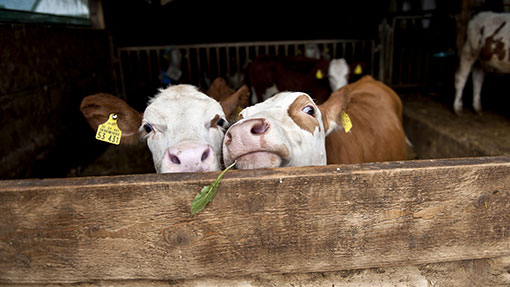Vet Viewpoint: Reducing pneumonia in calves and lambs

Chris McGregor, Clyde Vets, Lanarkshire
After the mild, wet winter, dung and slurry stores are full to capacity, but we are still encouraging our farmers to get sheds and pens mucked out and disinfected to reduce spread of scour and pneumonia through this year’s calf and lamb crop.
Good hygiene, a dry, draught-free environment and an adequate colostrum intake in the first six hours of life are key factors in ensuring good early health and optimum growth rates.
With better quality forage and a reduced fluke challenge all winter, stock are in much better condition this spring.
Cows and ewes have plenty of milk, lamb birthweights have been good and they are growing well.
However, we have been kept busy with numerous caesareans on pedigree flocks. This could be an indicator of what is to come when calving really kicks-off.
See also: Take our Farmers Weekly Academy on calf pneumonia
Mike Thorne, Rutland Vets, Rutland
So far this year we have not seen any Schmallenberg and with the mild winter, stock in the East Midlands have fared relatively well.
This has allowed us to make inroads into the thousands of cattle we now have to TB test.
We are now in an annual testing area, having previously been mostly in a four-yearly testing area. Fortunately, in spite of increased testing, we have not found much in the way of new TB cases.
We have also focused on farmer training in January and February with courses in bovine viral diarrhoea, calf rearing, lambing and basic veterinary emergency techniques.
With a younger generation of stockman eager to expand their skills, the courses are very practically orientated.
This enables them to tackle the most common presentations in delayed calvings and lambings and then care for the newborn. In a nutshell, saving vet costs and improving welfare and productivity.
Jonno Cooper, Minster Vets, York
On the back of a very wet and mild winter, cattle and sheep farmers should be very aware of the fact that we are likely to have problems with parasites this year.
Useful information can be found on the NADIS website including monthly regional parasite forecasts.
To minimise the amount of worm eggs that the lambs will pick up, farmers should graze their ewes on “clean” pasture when they have lambs at foot.
Pasture contamination from the ewes can be in some cases be minimised by the use of a wormer in the ewes, prior to turnout.
This should be targeted to gimmers, ewes in poor condition and ewes with twins and triplets.
Fit ewes with singles should be left unwormed. Clean pasture is that which has either been re-seeded, or grazed by cattle last year. Contact your vet for planned worming advice throughout the season.
Rob Smith, Farm First Vet Services, Monmouthshire
The recent media furore over the leaked results of the inquiry into the efficiency and humaneness of the recent badger cull has brought home to me the difficult job the industry has of getting across a balanced message.
This was highlighted further in an interview on Radio 4 involving an eloquent scientist promoting the leaked findings and an NFU representative defending the cull procedure.
I’m sure part of the problem is that the media may be more interested in talking to the likes of Brian May than to less media “sexy” organisations like the British Cattle Veterinary Association, but we do all need to get better at getting the message across. As we wait, the disease continues to sweep north and east across the UK and about 30,000 cattle a year lose their lives.
Vet Viewpoint A regional monthly round-up of key veterinary issues from members of the XL Vets group.
